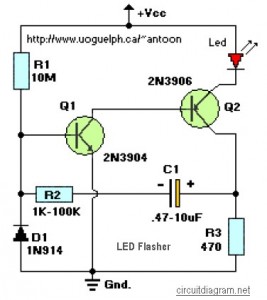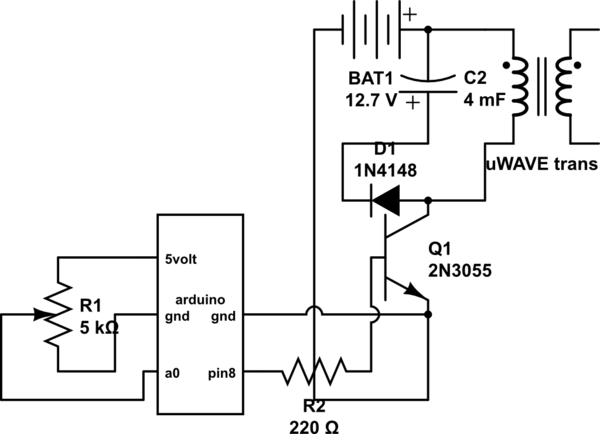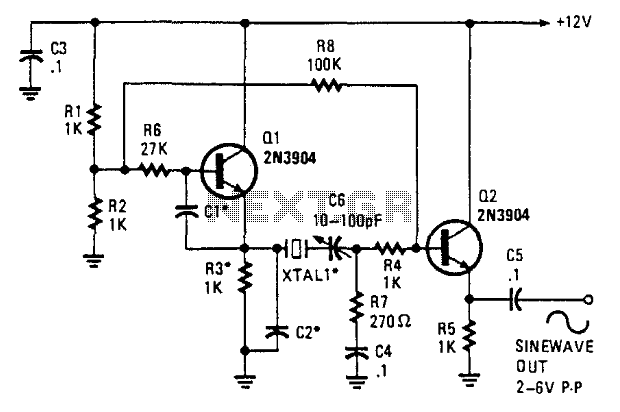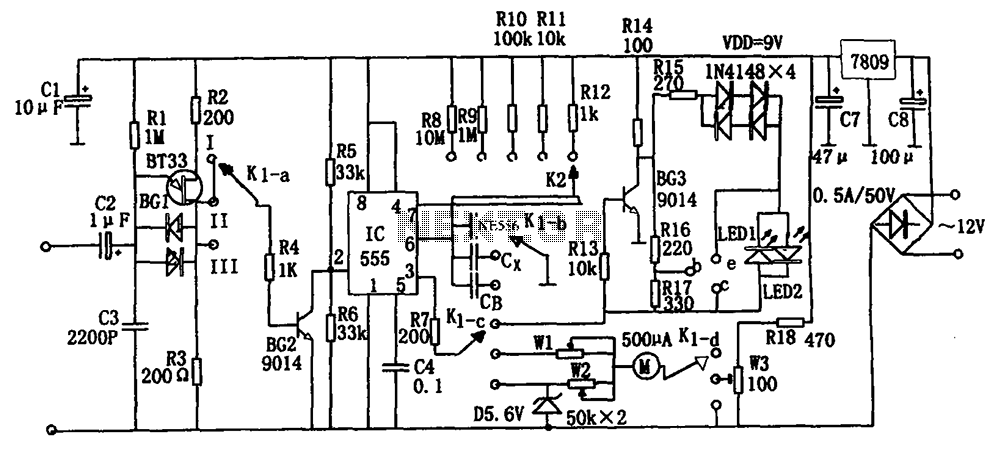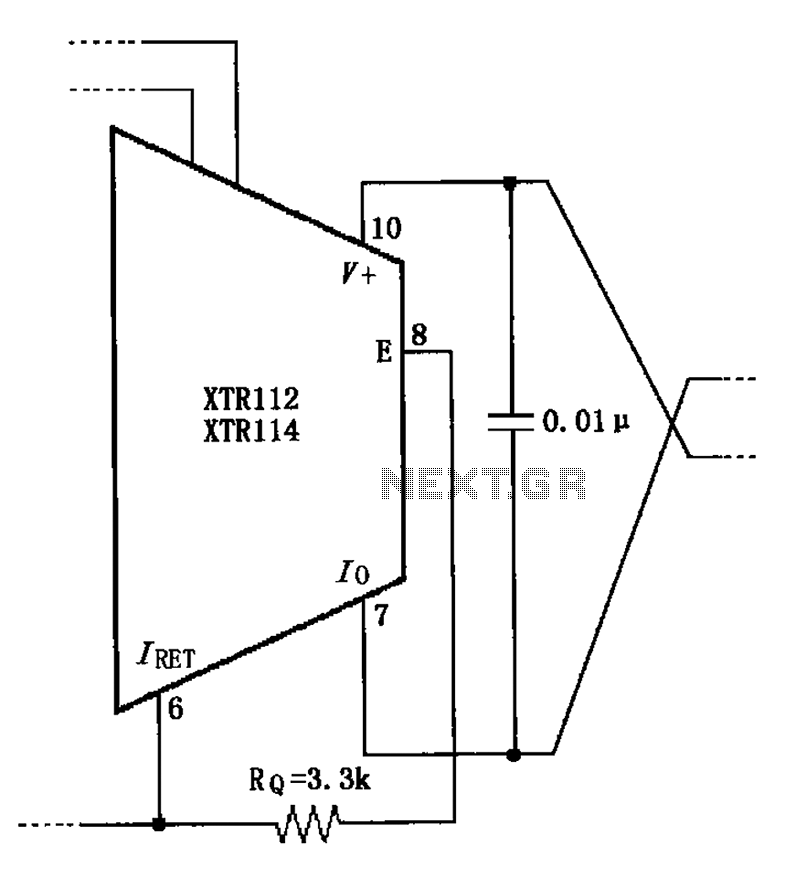
Unijunction Transistor Tutorials

The unijunction transistor (UJT) consists of a bar of N-type material with a P-type junction (the emitter) positioned near the center. Base 1 is connected to zero volts, while base 2 is connected to the positive supply. The resistance between the two bases, known as the interbase resistance, is typically 10k ohms. When the emitter is unconnected, the bar functions as a potential divider, resulting in approximately 0.5 volts appearing at the emitter. If a voltage is applied to the emitter, as long as it remains below 0.5 volts, no action occurs since the P-N junction is reverse-biased. Once the emitter voltage surpasses 0.5 volts, the junction becomes forward-biased, allowing emitter current to flow. This increase in current corresponds to a decrease in resistance between base 1 and the emitter. In the circuit, capacitor C charges through resistor R1. When the voltage across C exceeds 0.6 volts, the b1/emitter junction transitions to low resistance, discharging C. This process produces a sawtooth waveform across C. Additionally, a pulse of current flows through resistor R3, generating a pulse of voltage across it. This configuration is referred to as a relaxation oscillator, where the voltage across C charges gradually and then discharges suddenly.
The unijunction transistor (UJT) operates based on its unique structure, allowing it to function effectively as a relaxation oscillator. The device features a single P-N junction that creates a characteristic negative resistance region, making it suitable for generating oscillatory waveforms. The operation begins with the application of a voltage to the emitter, which is critical for the triggering of the device.
In practical applications, the capacitor C is charged through the resistor R1 at a rate determined by the RC time constant. The value of R1 and the capacitance of C directly influence the frequency of oscillation. As the voltage across C rises, the emitter voltage eventually reaches the threshold of 0.6 volts, causing the UJT to switch from a high-resistance state to a low-resistance state. This transition allows the capacitor to discharge rapidly, creating a sharp pulse of voltage.
The output pulse generated across R3 can be utilized for various applications, including triggering other circuits or providing timing signals. The sawtooth waveform produced across C can be further processed or filtered depending on the specific requirements of the application. The simplicity and effectiveness of the UJT in generating oscillations make it a valuable component in electronic circuits where timing and waveform generation are essential.
In summary, the unijunction transistor serves as a versatile component in electronic design, enabling the creation of oscillatory signals through its unique characteristics and operational principles.The unijunction transistor (UJT) is made of a bar of N type material with a P type junction (the emitter) near the centre. Base 1 is connected to zero volts and base 2 to the positive supply. The resistance between the two bases (the INTERBASE RESISTANCE) is typically 10k. With the emitter unconnected, the bar acts as a potential divider, and abou t 0. 5 volts appears at the emitter. If a voltage is connected to the emitter, as long as it is less than 0. 5 volts, nothing happens, as the P-N junction is reversed biased. (see the right hand diagram). When the emitter voltage exceeds 0. 5 volts, the junction is forward biased and emitter current will flow. This increase in current is equal to a reduction of resistance between base 1 and the emitter. In the circuit, C charges via R1. When the voltage across C exceeds 0. 6 volts, the b1/emitter junction goes low resistance and discharges C. The result is a sawtooth waveform across C. There is also a pulse of current through R3, giving a pulse of voltage across it. This circuit is called a relaxation oscillator. The voltage across C charges up slowly then suddenly relaxes. 🔗 External reference
The unijunction transistor (UJT) operates based on its unique structure, allowing it to function effectively as a relaxation oscillator. The device features a single P-N junction that creates a characteristic negative resistance region, making it suitable for generating oscillatory waveforms. The operation begins with the application of a voltage to the emitter, which is critical for the triggering of the device.
In practical applications, the capacitor C is charged through the resistor R1 at a rate determined by the RC time constant. The value of R1 and the capacitance of C directly influence the frequency of oscillation. As the voltage across C rises, the emitter voltage eventually reaches the threshold of 0.6 volts, causing the UJT to switch from a high-resistance state to a low-resistance state. This transition allows the capacitor to discharge rapidly, creating a sharp pulse of voltage.
The output pulse generated across R3 can be utilized for various applications, including triggering other circuits or providing timing signals. The sawtooth waveform produced across C can be further processed or filtered depending on the specific requirements of the application. The simplicity and effectiveness of the UJT in generating oscillations make it a valuable component in electronic circuits where timing and waveform generation are essential.
In summary, the unijunction transistor serves as a versatile component in electronic design, enabling the creation of oscillatory signals through its unique characteristics and operational principles.The unijunction transistor (UJT) is made of a bar of N type material with a P type junction (the emitter) near the centre. Base 1 is connected to zero volts and base 2 to the positive supply. The resistance between the two bases (the INTERBASE RESISTANCE) is typically 10k. With the emitter unconnected, the bar acts as a potential divider, and abou t 0. 5 volts appears at the emitter. If a voltage is connected to the emitter, as long as it is less than 0. 5 volts, nothing happens, as the P-N junction is reversed biased. (see the right hand diagram). When the emitter voltage exceeds 0. 5 volts, the junction is forward biased and emitter current will flow. This increase in current is equal to a reduction of resistance between base 1 and the emitter. In the circuit, C charges via R1. When the voltage across C exceeds 0. 6 volts, the b1/emitter junction goes low resistance and discharges C. The result is a sawtooth waveform across C. There is also a pulse of current through R3, giving a pulse of voltage across it. This circuit is called a relaxation oscillator. The voltage across C charges up slowly then suddenly relaxes. 🔗 External reference
